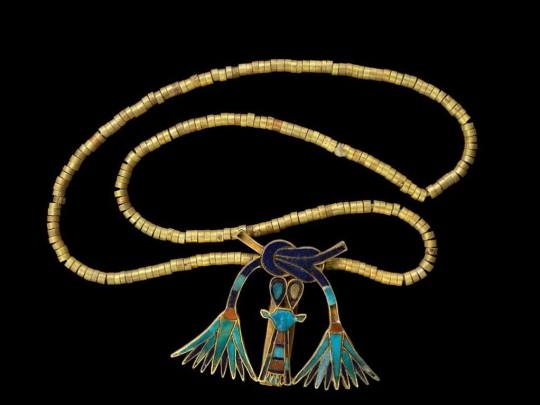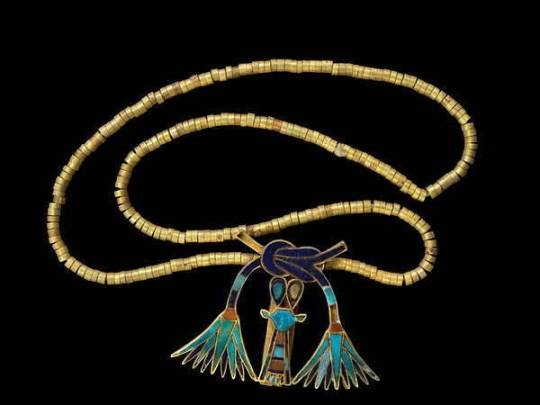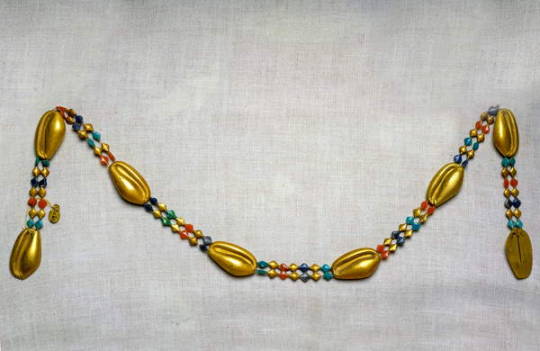#Sithathor
Explore tagged Tumblr posts
Text

Fastener of Princess Sithathor
Middle Kingdom, 12th Dynasty, ca. 1991-1803 BC. Funerary Complex of Senusret III at Dahshur. Now in the Egyptian Museum, Cairo. JE 30862 Photo: Sandro Vannini
Read more
194 notes
·
View notes
Note
1. Who is your favourite historical person?
17. What historical item would you like to own?
29. Great historical mystery you are interested in?
Thanks <3! And love your blog btw
Hi Anon!
I answered n.1 already but this gives me the perfect opportunity to add that I also own a lot of books about Charlie Luciano (the gangster). I wouldn't consider him a "favourite", but he gets a honorable mention
17. What historical item would you like to own?
I am actually gonna cheat because I can't choose: I am torn between T. E. Lawrence's motorcycle and this Pectoral of Sithathor that lives rent free in my head
29. Great historical mystery you are interested in?
Honestly I have never been to interested in historical mysteries. The closest thing I can think of are the pyramids. But I am very much one of those "i know humans built the piramids" people, so I don't really wonder too much about it <3
1 note
·
View note
Photo



“Parure Pectorale de la Princesse Sathathoriounet arborant le Cartouche d'Amenemhat III" en or, cornaline et lapis-lazuli, "Bracelet de Cheville avec Breloques en Forme de Griffes et Fermoir à Noeud" en or, lapis-lazuli, cornaline et turquoise et "Collier avec Pendentif de la Princesse Sithathor" en or, cornaline, lapis-lazuli et turquoise (Moyen Empire, 12e Dynastie) présentés à l'exposition “Ramsès & l'Or des Pharaons” à la Grande Halle de la Villette, Paris, mai 2023.
#expos#Pharaon#inspirations bijoux#email#turquoise#cornaline#LapisLazuli#Sathathoriounet#AmenemhatIII#Sithathor#RamsesII#GrandeHalleVillette
10 notes
·
View notes
Photo

Necklace of Princess Sithathor This clasp takes the form of two lotus flowers, between them hangs an image of the Goddess Bat. It will originally have fitted to a necklace. Fastener of a necklace belonging to princess Sithathor, made of gold, carnelian, lapis lazuli and turquoise, from the Tomb of princess Sithathor. Middle Kingdom, 12th Dynasty, ca. 1991-1803 BC. Funerary Complex of Senusret III at Dahshur. Now in the Egyptian Museum, Cairo. #egyptology_misr #Egypte #Agypten #Egipt #Egipto #Egitto #Египет #مصر #मिस्र #エジプト #埃及 #Egypten #Visit_Egypt #discover_Egypt #Experience_Egypt #diving #socialmedia #egypt #iloveegypt #luxor #karnak #mylifesamovie #mylifesatravelmovie #travelblog #travelblogger #solotravel #wanderlust #gopro #egyptology #ancientegypt (at Egyptian Museum) https://www.instagram.com/p/CFQbOdAl8aq/?igshid=5ojhd36cljns
#egyptology_misr#egypte#agypten#egipt#egipto#egitto#египет#مصر#मिस्र#エジプト#埃及#egypten#visit_egypt#discover_egypt#experience_egypt#diving#socialmedia#egypt#iloveegypt#luxor#karnak#mylifesamovie#mylifesatravelmovie#travelblog#travelblogger#solotravel#wanderlust#gopro#egyptology#ancientegypt
1 note
·
View note
Photo

Necklace of princess Sithathor Fastener of a necklace belonging to princess Sithathor, made of gold, carnelian, lapis lazuli and turquoise, from the Tomb of princess Sithathor. Middle Kingdom, 12th Dynasty, ca. 1991-1803 BC. Funerary Complex of Senusret III at Dahshur. Now in the Egyptian Museum, Cairo. https://www.instagram.com/p/B0n_yV6AkxQ/?igshid=1utsbymzt4yqs
0 notes
Text

Girdle of Princess Sithathor
Middle Kingdom, 12th Dynasty, ca. 1897-1878 BC. Tomb of Princess Sathathor, Funerary complex of Senusret III, Dahshur. Excavation by Jacques de Morgan, 1894 Now in the Egyptian Museum, Cairo. JE 30858
The girdle of the Princess Sithathor is made of eight gold, half-open cowry shells. The ones at each end have flat reverses, and were joined by means of grooves to serve as a clasp, fastening the girdle when they slid one into the other.
The shells are separated from each other by rhomboidal polychrome beads of carnelian, feldspar, and lapis lazuli. Gold cowry shells were imitations of the real cowry shells that had been used in belts, bracelets, anklets, and necklaces since the pre-dynastic period. People thought that cowry shells possessed powerful magical properties and increase female fertility.
Read more
53 notes
·
View notes
Photo

“Large Collier à Têtes de Fauconde la Princesse Khnoumit avec Perles Hiéroglyphiques" en or, cornaline, lapis-lazuli, turqoise et amazonite et "Ceinture de Hanches de la Princesse Sithathor Décorée de Coquilles de Cauris et Perles en Forme de Graines d'Acacia" en or lapis-lazuli, feldspath et cornaline (Moyen Empire, 12e Dynastie) présentés à l'exposition “Ramsès & l'Or des Pharaons” à la Grande Halle de la Villette, Paris, mai 2023.
#expos#inspirations bijoux#enfialge#coquillage#plumes#Knhoumit#Sithathor#RamsesII#cornaline#LapisLazuli#feldspath#turquoise#GrandeHalleVillette
1 note
·
View note
Photo

Girdle of Princess Sithathor This girdle of the Princess Sithathor is made of eight gold, half-open cowry shells. The ones at each end have flat reverses, and were joined by means of grooves to serve as a clasp, fastening the girdle when they slid one into the other. The shells are separated from each other by rhomboidal polychrome beads of carnelian, feldspar, and lapis lazuli. Gold cowry shells were imitations of the real cowry shells that had been used in belts, bracelets, anklets, and necklaces since the pre-dynastic period. People thought that cowry shells possessed powerful magical properties and increase female fertility. Princess Sithathor was a daughter of King Senusret II, and was most probably a sister of Senusret III, as she was buried within his pyramid complex at Dahshur. Very fine pieces of jewelry that belonged to her were found in her tomb; they are now preserved in the Egyptian Museum in Cairo. #MuseumFromHome #bkmegyptianart #ancientring #Egypt#AncientEgyptian #JewelryAncientEgyptian #Jewelleryancientegyptian #ringsancientegyptian #scarabsrings#scarabs#16thcentury #15thcentury #14thcentury #newkingdom #jewellerybloger #instajewelry #egyptological #egyptianjewelry #tutankhamón (at Egyptian Museum) https://www.instagram.com/p/B--AqY1ByIn/?igshid=wrs6wxnhqj4l
#museumfromhome#bkmegyptianart#ancientring#egypt#ancientegyptian#jewelryancientegyptian#jewelleryancientegyptian#ringsancientegyptian#scarabsrings#scarabs#16thcentury#15thcentury#14thcentury#newkingdom#jewellerybloger#instajewelry#egyptological#egyptianjewelry#tutankhamón
0 notes
Photo

Necklace with a pectoral bearing the cartouche of Senusret II (gold, carnelian, turquoise and lapis-lazuli), from the Tomb of Princess Sithathor, next to the pyramid of king Senusret III at Dahshur. The frame of this pectoral is topped by a cavetto cornice. Below, at the center of the piece, is a cartouche of Senusret II, surmounted by the hieroglyphic symbol for gods. On either side of the cartouche is a hawk, each wearing the Double Crown of Upper and Lower Egypt, and standing on a neb-symbol, meaning gold. Behind each hawk is a cobra and a sun-disc, with each cobra passing through an ankh-symbol. The pectoral is attached to a chain of gold beads, and semi-precious stones. Middle Kingdom, 12th Dynasty, ca. 1991-1803 BC. Now in the Egyptian Museum, Cairo. #ancientegypt #egypt #archaeology #thisisegypt #ancient #science #awesome #amazing #wonderful #photography #photo #pic #travel #travelling #news #nature #geography #beautiful #nice #tour #tourism #youtube #instagram #trending #hieroglyphs #ancientworld #valleyofthekings #egyptology #pyramids (at Egyptian Museum) https://www.instagram.com/p/B895rPsBrTI/?igshid=i5g3lohpcira
#ancientegypt#egypt#archaeology#thisisegypt#ancient#science#awesome#amazing#wonderful#photography#photo#pic#travel#travelling#news#nature#geography#beautiful#nice#tour#tourism#youtube#instagram#trending#hieroglyphs#ancientworld#valleyofthekings#egyptology#pyramids
0 notes
Photo

Girdle of Princess Sithathor This girdle of the Princess Sithathor is made of eight gold, half-open cowry shells. The ones at each end have flat reverses, and were joined by means of grooves to serve as a clasp, fastening the girdle when they slid one into the other. The shells are separated from each other by rhomboidal polychrome beads of carnelian, feldspar, and lapis lazuli. Gold cowry shells were imitations of the real cowry shells that had been used in belts, bracelets, anklets, and necklaces since the pre-dynastic period. People thought that cowry shells possessed powerful magical properties and increase female fertility. Princess Sithathor was a daughter of King Senusret II, and was most probably a sister of Senusret III, as she was buried within his pyramid complex at Dahshur. Very fine pieces of jewelry that belonged to her were found in her tomb; they are now preserved in the Egyptian Museum in Cairo. Middle Kingdom, 12th Dynasty, reign of Senusret II, ca. 1897-1878 BC. Now in the Egyptian Museum, Cairo. JE 30858 #egyptology_misr #Egypte #Agypten #Egipt #Egipto #Egitto #Египет #مصر #मिस्र #エジプト #埃及 #Egypten #Visit_Egypt #discover_Egypt #Experience_Egypt #diving #socialmedia #egypt #iloveegypt #luxor #karnak #mylifesamovie #mylifesatravelmovie #travelblog #travelblogger #solotravel #wanderlust #gopro #egyptology #ancientegypt (at Egyptian Museum) https://www.instagram.com/p/B4svTa9lbuy/?igshid=mm5xck2noiuz
#egyptology_misr#egypte#agypten#egipt#egipto#egitto#египет#مصر#म#エジプト#埃及#egypten#visit_egypt#discover_egypt#experience_egypt#diving#socialmedia#egypt#iloveegypt#luxor#karnak#mylifesamovie#mylifesatravelmovie#travelblog#travelblogger#solotravel#wanderlust#gopro#egyptology#ancientegypt
1 note
·
View note
Photo

Necklace of princess Sithathor Fastener of a necklace belonging to princess Sithathor, made of gold, carnelian, lapis lazuli and turquoise, from the Tomb of princess Sithathor. Middle Kingdom, 12th Dynasty, ca. 1991-1803 BC. Funerary Complex of Senusret III at Dahshur. Now in the Egyptian Museum, Cairo. https://www.instagram.com/p/B0n_yV6AkxQ/?igshid=1xhlg28aru7xp
0 notes
Photo

Sithathor Princess Belt "Sithathor" name means "daughter of Hathor" The belt consists of eight units of gold seashells that were used in belts, bracelets and necklaces since the pre-dynastic period have been linked and separated by multi-colored beads of agate and feldspar and Lapis, ancient Egyptians thought shells had strong magical properties and increased female fertility Princess Sithathor was the daughter of King Senusert the Second, and was probably the sister of Senusert the Third She is buried inside the Dahshur pyramid complex and very fine pieces of jewelry have been found in her tomb, now kept in the Egyptian Museum in Cairo. The Middle State Family 12 Around 1897 - 1878 BC Egyptian Museum#Tutankhamun ⠀⠀⠀ #egypt #ancientegypt #pharaohs #egyptian#äegypten #egyptology #wondersofegypt#ancient #archeology #middleeast#madeinegypt #hyeroglyphs #jewellery#Egipto #antiguoegipto #faraones#egipcios #egiptologia #antiguedades#arqueologia #jeroglificos #momias#kemet #loveegypt #thisisegypt #myegypt#egyptianhistory #tutankhamon (at Egyptian Museum) https://www.instagram.com/p/B1nwWPBABbT/?igshid=fi4t9xp1i1fs
#tutankhamun#egypt#ancientegypt#pharaohs#egyptian#äegypten#egyptology#wondersofegypt#ancient#archeology#middleeast#madeinegypt#hyeroglyphs#jewellery#egipto#antiguoegipto#faraones#egipcios#egiptologia#antiguedades#arqueologia#jeroglificos#momias#kemet#loveegypt#thisisegypt#myegypt#egyptianhistory#tutankhamon
0 notes
Photo

Necklace of princess Sithathor Fastener of a necklace belonging to princess Sithathor, made of gold, carnelian, lapis lazuli and turquoise, from the Tomb of princess Sithathor. Middle Kingdom, 12th Dynasty, ca. 1991-1803 BC. Funerary Complex of Senusret III at Dahshur. Now in the Egyptian Museum, Cairo. https://www.instagram.com/p/B0n_yV6AkxQ/?igshid=1jlpzn03yo0j9
0 notes